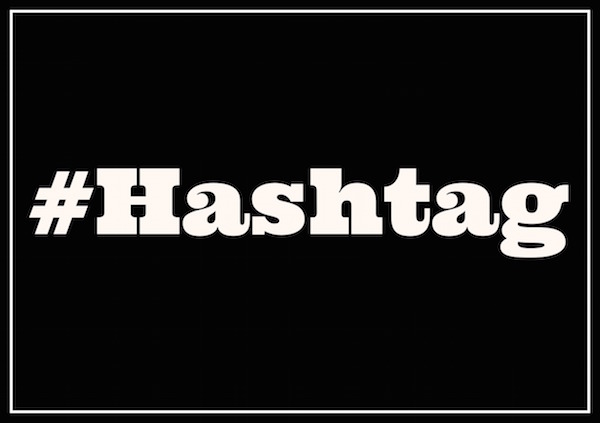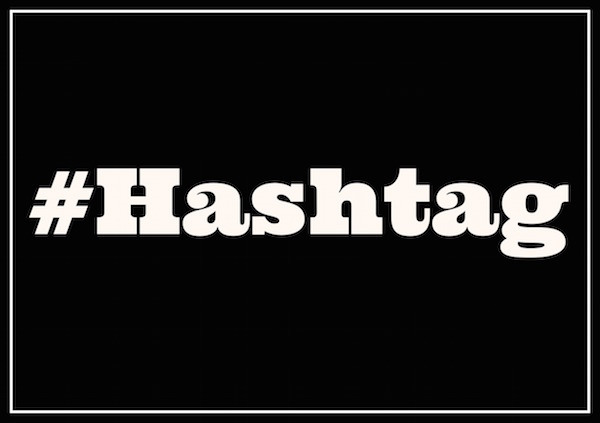One time, at a dinner event, I was asked by an older gentleman, “So, you know how hasthags work?”
Yes. Yes, I do.

These hashtags aren’t just used to highlight aspects of the post or the image associated with the post.
In most social networks, where hashtags are allowed to be used, the hashtag is actually a URL that sends a user to a post stream displaying all other posts with that specific hashtag on it.
Again, using the example, if I clicked on #bikestuff, I would then see all other posts using that specific hashtag.
Hashtags are powerful. And, often, they are not used correctly.
So, here are some pointers to get you going the right direction.
Tip 1. Always use hashtags...
Ok, may be not always. but often. Not every platform allows the use of hashtags. I mean, you can write #bikestuff into some, it just won't link anywhere. Likewise, don't force the use of a hashtag. Let them happen almost naturally and use them when they can enhance your content.
Tip 2. On Twitter, only use a few.
If you use more than 3, your hashtags lose relevancy. Use hashtags on this platform to categorize your posts.
Tip 3. On Instagram, you can use a lot.
Some research indicates you can use even more than 11 hashtags. However, I am of the belief that this makes posts just look kind of sophomoric. Feel free to use 5-7 , but personally, I just don’t like that many and tend to stick to my Twitter rule.
Tip 4. On Pinterest, use enough to define the product/idea.
Pinterest is a great platform to use hashtags, and once again you can use a metric-crap-load if you want to. However, this platform is a little more fluid. When using hashtags on Pinterest, align them with your brand and product, so when repins occur other users can recognize your name and product through the hashtags.
Tips 5. On Facebook, use a few, but really test this.
Facebook audiences are tough to calibrate for things like hashtags. Start off with the Twitter rule and work up to a high amount. Measure social engagements and then find your happy area. Odds are, it is around the 4-5 mark depending on the type of content.
Tip 5. Don’t listen to me, test your hashtags.
This should be at the end of every blog post located on every site.
I have tested hashtag use in multiple industries and multiple organizations. I have used none to using almost too many.
Test your outlets and your audience’s engagement when you begin to use hashtags. Maybe your audience loves hashtags on Facebook but doesn’t engage with you on Twitter when you use them?
As we venture deeper into 2015, many things tied to the dynamic face of digital marketing remain unknown. The power of Facebook's advertising for one. Does it have what it takes to last ? Or is just a fad till something newer comes along? That is just one.
User Experience, also known as UX however, is one of those aspects that remains very known, as far as its importance in how it impacts everything from app design to social media. Today, we are going to take a look at just five of the top reasons why UX is important and where. To narrow down the topics, we will focus on the mobile platform.
Mobile.
There is a plethora of statistics available that underscore the dire need and importance of mobile friendliness and marketing on the sea of devices in today's digital age. The user experience must be one that provides accessibility and visibility on all these devices out there (or at least the most popular to start). There is no other way about it. The User Experience must be smooth.

Way back in 2014, a bold prediction was made. It was made by Kleiner Perkins Caufield Byers' Mary Meeker, a reviewer of tech trends. The stats in this comScore report are pretty much historic in the mobile sphere. Mobile marketing has become not just a nice to have, but a necessity for nearly every type of business on the planet. This necessity has bolstered the importance of.. You guessed it. The designing of the User Experience. As mobile use heads Northward and the diversity of mobile devices grows (Especially Android), it now becomes more of how we analyze those consumers and their behavior when using any of those devices. Providing them with a User Experience that pulls them in and doesn't let them go is what we're all after.
Below I have noted 5 reasons why I feel User Experience is important in 2015 and beyond.
Personalizing the Experience
As competition moves forward non stop and competitors ramp up to get a leg up, showing users what they want when they want is keeping UX designers working overtime. We all know that content personalization has been a mainstay of desktop sites for quite some time via the use of cookies.
Today, designers are using the information they have about user devices coupled with lots of other metrics on user behavior, geographical and demographics to personalize the user experience via content and design. What you present along with how you present it has taken center stage, as visitors are presented with what is most useful to them at the exact time. UX design together with monitoring, collection and analysis of visitor behavior drives the goal of creating a productive and engaging personalized user experience.
There are tools such as Toonimo, that enhance the user experience with animated audio visual guides that are personalized for each visitor.
Making a Splash: Being found Online
When a mobile user seek information, they typically browse and and search through querying or accessing the social networks. UX designers are fully aware of the importance of formatting, labeling and organizing content so that people can access and understand the information that exists on these pages. The techniques they use to make sites easy to find will ensure that both people and search engines will be able to connect in a better fashion in the vast landscape of big data and small apps.
User Input
With the diverse array of mobile devices, where screen sizes run the gamut in length and width, creating a user experience that will satisfy the masses is not so easy. UX designers need to make the process of inputting data using one hand effortless, and with that limits the amount of information asked. The user input experience needs to be efficient and trimmed down to the most needed information. Registration fields need to be one click experiences whenever possible. Airline and hotel booking apps should show default information whenever possible, taken from user preferences or their last options.
Creating a solid mobile user experience, requires UX designers to think outside of the box and choose such input mechanisms such as motion and voice. For apps that don't require security save the login information whenever possible on the mobile device. Keeping the gestures to swiping, tapping and pinching will make for a smooth user experience.
Users like Gesturing
The list of gestures is growing. Not, only that, each platform has its own set of gestures. From tapping, swiping, pinching, and shaking. A big part of the user experience is how they make their mobile device do what they want without having to type or even speak. A few actions to get what they want will make it a user experience users will want to come back to and spread the word about.
Different groups of users prefer different gestures for different things. When designing an app that will be targeting a certain group like generation Xers or teenagers, designers are building apps with those groups in mind. They will know the type of device they are using, what OS and what they like to do to get the latest football scores or the latest stock quotes. So, whether it's a tap, double tap, flick, drag or two finger scroll, great UX means that the designer took all those things into account to decide what is best for their audience

Great design drives great User Experience
UX designers often work very closely with Digital Marketing teams and this will only increase in 2015 as the designers are tuned in the most with the user and can assist with lots of optimization on various campaigns. Digital marketers will continue to see the benefits when working with the UX design teams as it will provide loads of intelligence that revolves around how they position the product for sale and marketing.
What do you feel are the elements of UX that will emerge as most important in 2015. Please feel free to chime in below.

